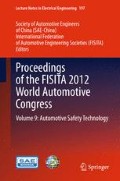Abstract
Post-impact pedestrian kinematics is complex and depends on various factors such as impact speed, height of the pedestrian, front-end profile of the striking vehicle and pedestrian posture, among others. The aim of this study is to investigate the main factors that determine post-crash pedestrian kinematics. A detailed study of NASS-PCDS (National Automotive Sampling System—Pedestrian Crash Data Study) showed that the vehicle–pedestrian interaction in frontal crashes can be categorized into four types. Pedestrian-vehicle size ratio and the impact speed are the two most influential factors that determine post crash pedestrian kinematics. The findings from the NASS-PCDS study were also confirmed and verified with the help of numerical simulations performed using two modified JAMA human FE models. An adult model (male, 175 cm and 72 kg) and a properly scaled child model (6 years old, 120 cm and 24.5 kg) were effectively utilized to investigate the post-crash kinematics in different conditions.
F2012-F03-010
Access this chapter
Tax calculation will be finalised at checkout
Purchases are for personal use only
References
Mizuno Y (2005) Summary of IHRA pedestrian safety WG activities. ESV 19 No. 138
Longhitano D et al (2005) Influence of vehicle body type on pedestrian injury distribution. In: SAE world congress
Serre T et al (2010) Child pedestrian anthropometry: evaluation of potential impact points during a crash. Accid Anal Prev 42(6):1943_1948
Kawabe Y (2012) Different factors influencing post-crash pedestrian kinematics. In: SAE world congress 2012-01-0271
Takayama S et al (2011) The clarification of individual injury mechanism difference in pedestrian FE model utilizing cadaver scaling and posturing techniques. ESV 22 No. 11-0414
Ejima S et al (2003) Modification and validation of human neck model under direct head loading. ESV 18 No. 333
Serre T et al (2009) Comparison between new data on children anthropometry and CRS dimensions. ESV 21, paper 09-0484
Yang J et al (2005) Correlation of different impact conditions to the injury severity of pedestrian real world accidents. ESV 19 paper 05-0352
Caris TL et al (2006) Cervical range of motion data in children. SAE 2006-01-1140
Schultz AB et al (1979) Mechanical properties of human lumbar spine motion segments part-I. Trans ASME 101:79–84
Begeman PC et al (1994) Visco-elastic shear response of the cadaver hybrid III lumbar spine. In: SAE world congress 942205
Nishimura R et al (2002) Development of the human FEM model for child pedestrian. JSAE spring convention, 20025504
Martin RB et al (1977) Age and sex-related changes in the structure and strength of the human femoral shaft. J Biomech 10:223–231
Acknowledgments
The authors would like to acknowledge the members of users’ support group of the ESI Japan, for PAM-CRASH and JARI for the adult human FE model.
Author information
Authors and Affiliations
Editor information
Editors and Affiliations
Rights and permissions
Copyright information
© 2013 Springer-Verlag Berlin Heidelberg
About this paper
Cite this paper
Murakami, D., Pal, C., Kawabe, Y., Okabe, T. (2013). Analysis of Pedestrian Kinematics and Injury Mechanism in Real World Accidents. In: Proceedings of the FISITA 2012 World Automotive Congress. Lecture Notes in Electrical Engineering, vol 197. Springer, Berlin, Heidelberg. https://doi.org/10.1007/978-3-642-33805-2_27
Download citation
DOI: https://doi.org/10.1007/978-3-642-33805-2_27
Published:
Publisher Name: Springer, Berlin, Heidelberg
Print ISBN: 978-3-642-33804-5
Online ISBN: 978-3-642-33805-2
eBook Packages: EngineeringEngineering (R0)

